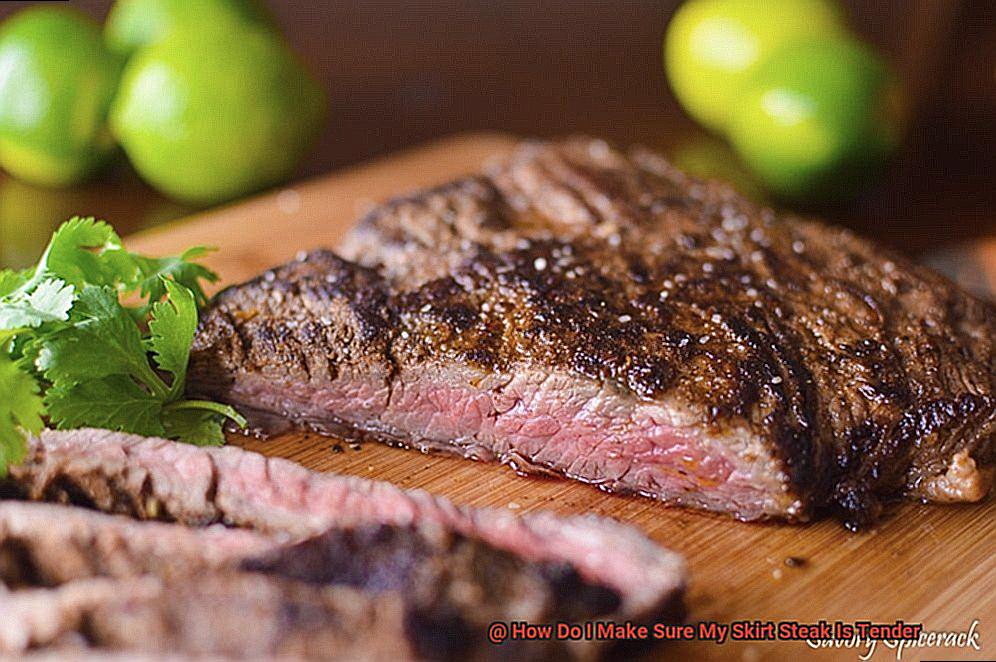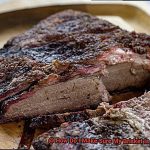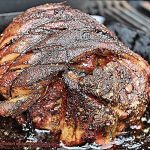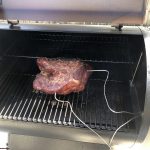Do you crave a delicious and juicy skirt steak dinner, only to end up with a tough and chewy piece of meat? It’s a common problem, but fear not. Today we’re going to discuss how to ensure your skirt steak is extra tender and succulent.
Skirt steak is an affordable cut of meat that’s packed with flavor. It’s no wonder it’s becoming increasingly popular in restaurants and homes alike. However, it requires some extra attention to reach its full potential. Whether you’re grilling, sautéing, or broiling your skirt steak, there are a few key factors to keep in mind to achieve that sought-after tender texture.
Firstly, marination is essential when it comes to skirt steak. A marinade not only infuses the meat with flavor but also helps break down the connective tissues, resulting in a tender and juicy steak. Secondly, avoid overcooking your skirt steak as it’s thin and can quickly become tough if cooked for too long. Lastly, don’t forget to give your steak a little rest before slicing – this allows the juices to redistribute evenly throughout the meat.
In this post, we’ll dive deeper into these points and share some tips and tricks to ensure your skirt steak is not only flavorful but also delightfully tender. So let’s get started on making sure that next time you enjoy that skirt steak dinner, it melts in your mouth and leaves you feeling satisfied and content.
Contents
Marinating the Steak: The Key to Adding Flavor and Breaking Down Tough Fibers
Skirt steak is a cut of beef that’s bursting with rich, beefy flavor. However, it can sometimes be tough and chewy if not cooked correctly. That’s where marinating comes in. Marinating your skirt steak is the secret to adding flavor and breaking down tough fibers, resulting in a juicy and tender final product.
The key to a successful marinade is to use acidic ingredients like vinegar or citrus juice. Acid helps break down the tough muscle fibers in the meat, making it easier to chew. Along with acid, your marinade should contain herbs, spices, and oil to add flavor.
There are plenty of marinades to choose from for your skirt steak. A classic marinade includes olive oil, balsamic vinegar, garlic, and herbs like rosemary or thyme. Alternatively, you can opt for soy sauce-based or citrus-based marinades to suit your taste preferences.
When marinating your skirt steak, keep a close eye on the time frame. For best results, marinate it for at least 30 minutes up to 24 hours. However, be cautious not to over-marinate as the acid can break down the meat too much and turn it mushy.
After marinating your skirt steak, remember to blot it dry with paper towels before grilling. This removes excess moisture from the surface of the meat and allows it to sear correctly on the grill, developing a mouth-watering crust.
Finally, cooking your skirt steak at high heat for a short amount of time is crucial for achieving a tender and juicy result. Avoid overcooking your steak as this will cause it to become dry and tough.
High Heat Cooking for a Juicy and Tender Result
The solution to your troubles is simple – high heat cooking methods. By cooking at high temperatures, you can achieve a juicy and tender result that will make your taste buds dance.
Grilling and broiling are two of the most popular high heat cooking methods for skirt steak. To grill, preheat the grill to high heat, pat the steak dry, season generously with salt and pepper, and cook for 3-4 minutes per side. Broiling is another excellent option; place the steak on a broiler pan or wire rack over a baking sheet, and broil for 3-4 minutes per side.
Remember to keep an eye on the temperature of the meat using a meat thermometer to prevent overcooking. Skirt steak should be cooked to an internal temperature of 130-135°F for medium-rare doneness or 140-145°F for medium doneness.
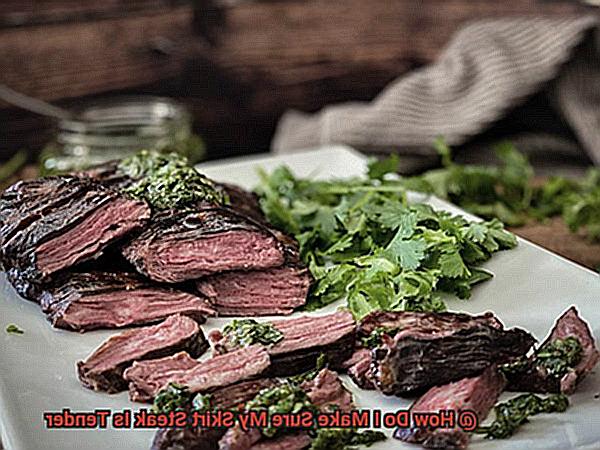
But wait, there’s more. To add even more flavor and tenderness to your skirt steak, marinate it overnight in an acidic marinade like vinegar or citrus juice. This technique helps break down the tough muscle fibers in the meat while infusing it with a delicious flavor. Just be sure not to over-marinate and blot it dry before cooking for that mouth-watering crust.
How to Grill Skirt Steak for Maximum Flavor
Grilling a juicy and flavorful skirt steak can be a challenge, but with the right steps, you’ll be able to get the perfect texture and taste. Here are five sub-sections to follow for grilling the best skirt steak that will leave your taste buds wanting more.
Select High-Quality Meat
To ensure maximum tenderness and flavor, choose a high-quality cut of meat. Look for a skirt steak that is well-marbled with fat as this helps keep it moist during cooking. Avoid overcooking the meat as it can become tough and chewy.
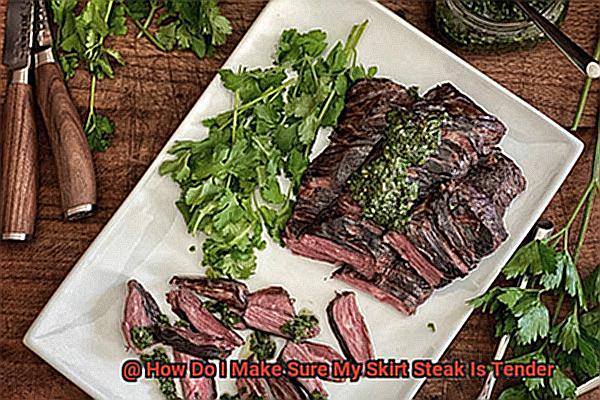
Season Properly
Proper seasoning is key to enhancing the natural flavor of your skirt steak. Use a simple rub of salt, pepper, and any other herbs or spices that you prefer. Massage the seasoning into the meat thoroughly to ensure even flavor distribution.
Cook Quickly Over High Heat
Skirt steak cooks rapidly, so it’s crucial to grill it quickly over high heat to create a nice crust on the outside while keeping the inside juicy and tender. Aim for about 3-4 minutes per side for medium-rare. Keep an eye on the meat to prevent overcooking, which can make it tough.
Let It Rest
After grilling, let your steak rest for at least 5-10 minutes before slicing and serving. This allows the juices to redistribute throughout the meat, resulting in a more tender and flavorful final product.
Slice Against The Grain
To maximize tenderness in each bite, slice your skirt steak against the grain. This technique helps break up the tough fibers of the meat and makes it easier to chew.
Tips for Searing Skirt Steak Perfectly Every Time
Look no further. Here are five expert tips to help you achieve a flawless sear every time.
Tip 1: Bring the Steak to Room Temperature
Before searing, make sure your steak has been at room temperature for about 30 minutes. This ensures that the steak cooks evenly and sears properly. A cold steak won’t cook evenly, resulting in a tough and chewy texture.
Tip 2: Generously Season the Steak
Season your steak liberally with salt and pepper before searing. This not only enhances the flavor of the steak but also helps to create a delicious crust when searing. Use a high smoke point oil, like canola or vegetable oil, to prevent the oil from burning and creating a bitter taste.
Tip 3: Preheat Your Pan or Grill
Make sure your pan or grill is hot before adding the steak. You should hear a sizzle when the steak hits the pan or grill. Don’t overcrowd the pan or grill as this will prevent proper searing and may result in a steamed rather than a seared steak.
Tip 4: Resist the Urge to Move the Steak
Once you’ve added the steak to the pan or grill, resist the urge to move it around. Let it cook undisturbed for 2-3 minutes on each side until a nice crust has formed. Overcooking the steak will result in a tough texture, so be careful not to leave it on for too long.
Tip 5: Let it Rest
After searing both sides of the steak, let it rest for a few minutes before slicing. This allows the juices to redistribute throughout the meat, resulting in a more tender and flavorful dish.
The Benefits of Sous-Vide Cooking for Skirt Steak
Look no further than sous-vide cooking. This technique has taken the culinary world by storm for its ability to produce tender and flavorful meat, and it’s especially useful for tougher cuts like skirt steak.
One of the main advantages of sous-vide cooking for skirt steak is the precise temperature control it offers. No more guesswork – you can set the temperature to exactly what you want and trust that every inch of your steak will be cooked evenly. This means no more dry, overcooked edges or undercooked centers.
But temperature control is just the beginning. Because the steak is cooked at a low temperature for an extended period of time, connective tissues break down slowly, resulting in a melt-in-your-mouth texture. Say goodbye to chewy, tough bites and hello to juicy, tender perfection.
And let’s not forget about flavor. With sous-vide cooking, you have the opportunity to infuse your steak with any herbs, spices, or marinades you desire. Simply seal the steak in a bag with your chosen seasonings and let them work their magic during the cooking process. The result? A more intense and complex flavor profile without any additional effort.
How to Choose the Best Quality Beef for Skirt Steak
Skirt steak is a cut of beef that can be tough if not prepared properly. But, with the right selection of high-quality beef, you’re on track to creating a tender and flavorful skirt steak. Here are some tips that will help you choose the best quality beef for your skirt steak:
Look for Even Marbling
The marbling of the beef is important when selecting a cut of meat for your skirt steak. The small streaks of fat throughout the meat help keep it moist and tender during cooking. Look for beef with even and plentiful marbling, as it adds flavor and tenderness to the meat.
Consider Age and Grade
The age and grade of the beef are two critical factors that determine its quality. Younger beef is generally more tender than older beef. Look for beef that is labeled “choice” or “prime” grade, as these grades indicate a higher quality of meat. Additionally, consider purchasing grass-fed beef, which tends to have a more robust flavor and higher nutritional value than grain-fed beef.
Check Color and Texture
The color and texture of the meat are also important factors to consider. The color should be bright cherry-red or deep burgundy, with a firm texture. Avoid meat that is discolored or has a slimy or sticky texture, as these are signs of spoilage. Always purchase your beef from a reputable source that sources their beef from trusted farms.
Visit a Specialty Meat Shop
Consider visiting a local butcher or specialty meat shop where the staff can provide guidance on selecting the best quality beef for your needs. They may also be able to provide specific recommendations based on your recipe or cooking method. Specialty meat shops typically source their products from trusted farms and offer high-quality cuts of meat.
The Importance of Allowing the Steak to Rest After Cooking
Look no further than the crucial step of allowing your steak to rest after cooking.
As you cook a steak, the heat causes the juices in the meat to migrate towards the center. If you slice into it straight away, all those delicious juices will escape onto your cutting board, leaving you with a less than desirable meal. This is where resting comes in.
Resting your steak for at least 5-10 minutes gives those juices time to redistribute throughout the meat. This results in a more evenly cooked, juicy steak that will leave your taste buds dancing with delight. Not only does this simple technique improve the texture and flavor of your steak, but it also gives you time to prepare any sides or sauces that will accompany your meal.
So how do you rest your steak? It’s easy. Once it’s cooked to perfection, remove it from the heat source and place it on a cutting board or platter. Remember to loosely tent it with foil to keep it warm and let it sit for at least 5-10 minutes before slicing and serving.
Here are some additional tips for achieving the perfect rested skirt steak:
- Use a meat thermometer to ensure your steak reaches the desired internal temperature before resting.
- Don’t cover the steak too tightly with foil as it can cause steam buildup, resulting in a soggy crust.
- For an even better result, season your steak with salt at least an hour before cooking, allowing it to penetrate and enhance the flavor.
Common Mistakes When Making Skirt Steak
There are a few common mistakes that people make when cooking this flavorful cut of meat that can easily be avoided with a few simple tips.
First and foremost, it’s essential to tenderize the meat before cooking. Skirt steak is a tougher cut of meat, and failing to tenderize it properly can result in an unpleasant texture. To do this, consider marinating the steak in an acidic marinade for at least an hour before cooking. Alternatively, use a meat tenderizer to break down the muscle fibers and make it more tender.
Once you’ve got your tenderizing technique down, it’s time to talk about cooking methods. One of the most significant mistakes people make when cooking skirt steak is overcooking it. This cut should be cooked quickly over high heat, such as on a grill or in a cast-iron skillet. Overcooking can cause skirt steak to become dry and tough, so it’s essential to monitor the internal temperature of the steak with a meat thermometer.
Another common mistake is using the wrong cooking method altogether. Skirt steak is best cooked using dry heat methods such as grilling, broiling, or pan-searing. Braising or stewing can result in an overly soft and mushy texture that doesn’t showcase the flavor of this cut of meat.
Lastly, don’t forget to let your skirt steak rest after cooking. Allowing it to rest for at least five minutes before slicing and serving allows the juices in the meat to redistribute and settle, resulting in a juicier and more tender final product.
Conclusion
In conclusion, a perfectly tender and juicy skirt steak is within reach if you follow a few key tips. First and foremost, marinating your steak is essential to break down the tough fibers and add flavor. But don’t stop there – take the time to select a high-quality cut of beef with even marbling, appropriate age and grade, and the right color and texture.
When it comes to cooking your skirt steak, high heat methods such as grilling or broiling for a short amount of time are crucial to avoid overcooking and drying out the meat. And don’t forget to let it rest before slicing. This allows the juices to redistribute throughout the meat for maximum tenderness and flavor.
Of course, avoiding common mistakes is just as important as following these steps. Be sure to properly tenderize your meat, use the correct cooking method, avoid overcooking, and always let it rest after cooking.
With these tips in mind, you can confidently tackle this affordable yet flavorful cut of meat. Impress your family and friends with an expertly cooked skirt steak that melts in your mouth and leaves you feeling satisfied.

